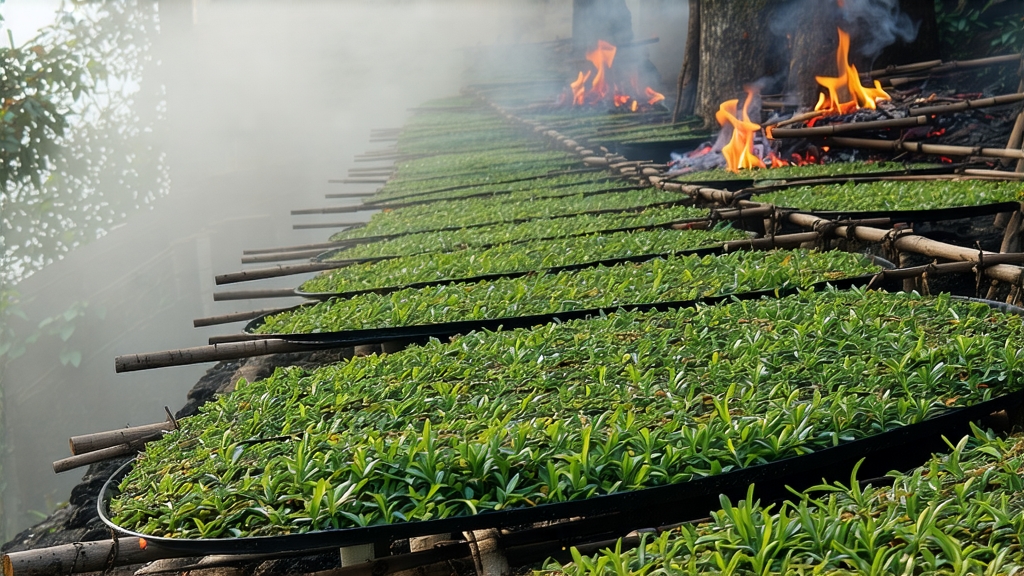
When European tea clippers first rounded the Cape of Good Hope in the mid-seventeenth century, the cargo that most excited London merchants was not silk or porcelain but a small, leathery leaf from the Wuyi Mountains of northern Fujian. That leaf—called Lapsang Souchong—was the world’s first intentionally oxidised black tea, and its arrival forever changed global drinking habits. Today, while Keemun, Assam and Ceylon have become household names, the original pine-smoked black tea remains a cult classic, equally loved for its campfire perfume and its layered, malty sweetness. This article invites international drinkers to rediscover the ancestor of all black teas: its birth among bandits and Buddhist monks, its two distinct manufacturing styles, the subtle choreography of brewing it gongfu-style, and the sensory code that unlocks its quiet elegance.
Historical backdrop: from Ming frontier tea to London drawing rooms
The Wuyi massif is a UNESCO dual heritage site where 36 peaks and 99 valleys create a humid micro-climate veiled in cloud nine months of the year. During the late Ming dynasty (c. 1600 CE), local monks began experimenting with fully oxidising tea to extend shelf life along the perilous mountain trade routes. The new “hong cha” (red tea) travelled down the Nine-Dragon Gorge to the river port of Xingcun, where Dutch traders christened it “Bohea.” Because the tea arrived after months at sea tasting robust and smoky, Europeans assumed the flavour was intrinsic; in reality, the pine smoke was added later, initially as a preservative against South-China humidity. By the 1662 marriage of Charles II to Catherine of Braganza, Portuguese princess and tea devotee, Lapsang Souchong had become the prestige tipple of Restoration London, priced higher than silver by weight.
Two families, two styles: traditional pine-smoke vs. unsmoked “wuyi black”
Modern connoisseurs recognise two legitimate descendants of the original Bohea. The classic “Song Zhong” (Pine-variety) is still produced in Tongmu Guan, a protected village inside the Wuyi National Nature Reserve. Here, the final drying stage is carried out over a slow fire of local Masson pine and cedar, imparting a resinous, longan-sweet aroma that adheres to the leaf for years. Since 2005 an unsmoked version called “Zheng Shan Xiao Zhong” has also emerged, requested by exporters seeking a cleaner cup for Western palates. Both teas share the same two-leaf-and-a-bud pluck from the small-leaf “cai cha” cultivar, but diverge at the firing stage, yielding either a whisky-coloured liquor laced with campfire notes, or a burgundy infusion reminiscent of cocoa and dried fig.
Craft in detail: eight steps from misty cliff to tin
- Plucking: only April buds at 800–1 200 m elevation, when morning mist blocks direct sunlight, preserving amino acids.
- Withering: leaves are spread on bamboo trays inside Qing-era wooden lofts, softly warmed by the mountain breeze; 60 % moisture loss takes 8–10 h.
- Rolling: a 45-minute gentle roll breaks cell walls without pulverising tips, starting enzymatic oxidation.
- Oxidation: trays rest in a humid pine-room at 24 °C; oxidation is arrested the moment the leaf turns maroon-copper (about 3 h).
- Pan-firing: a quick 200 °C toss halts oxidation and sets the malt base.
- Rolling again: tighter twists help the final smoke adhere evenly.
- Pine-smoke drying (Song Zhong only): leaves are placed on multi-tier bamboo racks above a pinewood pit smouldering at 80–90 °C for 6–8 h; artisans add fresh resinous shavings every 30 min, allowing smoke—not flame—to kiss the leaf.
- Rest & sort: the tea cools in open wicker baskets for 48 h, letting volatiles stabilise, then is hand-sorted to remove stems and yellow leaves.
Terroir translated into flavour
Tongmu’s soil is a coarse granitic sand rich in quartz and iron; drainage is instant, forcing roots to dive three metres for water, concentrating polyphenols. The result is a tea that balances sweetness (honey, longan